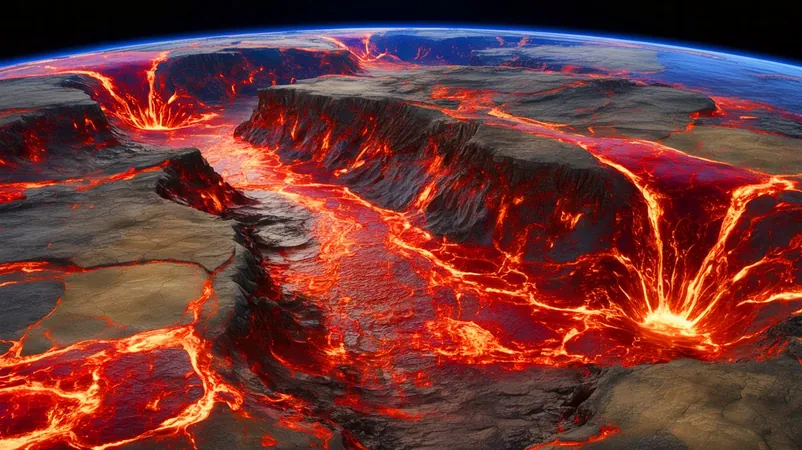
Revolutionary Discovery Shatters Our Understanding of Earth's History: Continents Began Forming 4.3 Billion Years Ago!
2025-09-16
Author: Kai
A Groundbreaking Revelation in Geological Science
The age-old mystery surrounding the formation of Earth's continents has just taken a dramatic turn! New research indicates that these colossal landmasses began taking shape significantly earlier than previously believed. Through cutting-edge geodynamic models and detailed analysis of ancient crystals, scientists have unlocked new insights into Earth's tumultuous early geological history.
Ancient Crystals: Unlocking Secrets of the Past
At the heart of this revolutionary study lies the chemical signatures embedded in ancient rocks. In particular, scientists examined melt inclusions trapped in green olivine crystals that dared to hold remnants of ancient magma over 3 billion years old. By exploring the strontium isotope ratios within these inclusions, the research team discovered unexpected anomalies in the chemical makeup of the mantle.
Lead researcher Adrien Vezinet highlights the importance of these findings, suggesting that the presence of unradiogenic strontium mantle sources indicates that continental crust may have begun forming as early as 4.3 billion years ago. This jaw-dropping discovery not only rearranges the timeline of continental evolution but also raises intriguing questions about the very processes that sculpted our planet.
The Role of Tectonic Movement and Subduction
Tectonic activity has always been a crucial player in shaping Earth's landscape. Previously, scientists thought that subduction—a process vital for creating mountain ranges and earthquakes—was either absent or less intense in Earth's early history. However, groundbreaking geochemical data and advanced computer simulations tell a different story.
This new study reveals that during the Hadean period, subduction processes were intermittent and triggered by massive mantle plumes. These dynamic forces initiated periods of weakened lithosphere, allowing for crust formation. This fluctuating model of tectonic activity contradicts past beliefs of a rigid, inactive Earth, suggesting a much more vibrant landscape in its formative years.
The Dynamic Evolution of Earth's Early Mantle
Exploring the forces that shaped Earth’s mantle during its genesis involves cutting-edge geochemical analysis and robust computational modeling. Gear up, because isotopic studies and geodynamic simulations have led to groundbreaking revelations: mantle plumes were pivotal in kickstarting tectonic activities in the early Earth.
Vezinet notes that the presence of an unradiogenic strontium mantle points to significant depletion by the time the first crust began to form. The Hadean mantle was anything but passive—it was a dynamic, molten environment, radically reshaping our comprehension of how early geological processes unfolded.
Implications for Climate and Life's Evolution
The formation of continental crust predates human existence—and its implications resonate far beyond geology. This early crust likely played a crucial role in stabilizing Earth's climate and shaping the conditions necessary for life to thrive. The recycling of materials back into the mantle during these formative years could have dramatically altered atmospheric and oceanic compositions, setting the stage for life's building blocks.
If continental crust was forming and recycling at such an early stage, it indicates that Earth’s surface was more active and intricate than ever thought possible!
Rethinking Earth's Timeline and Its Cosmic Implications
These astonishing findings challenge long-held beliefs about Earth’s early history and illustrate the dynamic nature of our planet. As we continue to probe into Earth's ancient past, we must also consider how these revelations might influence our understanding of other planets within our solar system and beyond.
The past just got a whole lot more exciting—stand by for a monumental shift in how we perceive the evolution of our planet!


 Brasil (PT)
Brasil (PT)
 Canada (EN)
Canada (EN)
 Chile (ES)
Chile (ES)
 Česko (CS)
Česko (CS)
 대한민국 (KO)
대한민국 (KO)
 España (ES)
España (ES)
 France (FR)
France (FR)
 Hong Kong (EN)
Hong Kong (EN)
 Italia (IT)
Italia (IT)
 日本 (JA)
日本 (JA)
 Magyarország (HU)
Magyarország (HU)
 Norge (NO)
Norge (NO)
 Polska (PL)
Polska (PL)
 Schweiz (DE)
Schweiz (DE)
 Singapore (EN)
Singapore (EN)
 Sverige (SV)
Sverige (SV)
 Suomi (FI)
Suomi (FI)
 Türkiye (TR)
Türkiye (TR)
 الإمارات العربية المتحدة (AR)
الإمارات العربية المتحدة (AR)